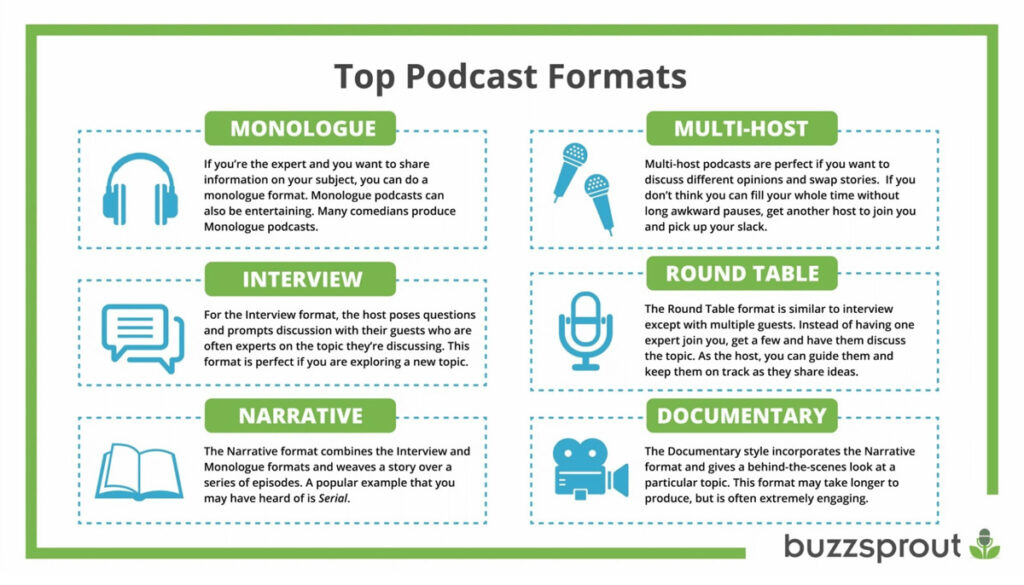The Power of Podcasts: Best Practices for a Standout Show
So, you gave it some thought and you’re ready to start a podcast. Or maybe you already have one but want to grow your reach. But how do you compete with five million other podcasts?
Yep, you read that right. The podcast market is booming in every corner of the world. It’s a 23-billion-dollar industry, en route to hit 100 billion by 2030. In this article, we put the world of podcasting under the microscope, exploring the tips, tricks, and trends shaping the landscape, so you can run a standout show.
Why do a podcast?
We know what you’re thinking: if the podcast market is saturated, why have one at all, especially with so many other channels at your disposal?
To start, your audience is probably listening.
Podcast listenership has almost doubled over the last five years, up from 275 million listeners in 2019 to an estimated 500 million in 2024. These are captive audiences who intentionally seek out niche topics. They actively invest their time and attention.
If your podcast is good, listeners become intimately immersed and more receptive to your messaging.
Secondly, your competitors are probably doing it. Fifty per cent of marketers are using podcasts to reach their audience. If you don’t want your competitors stealing your date, you need to show up to the party.
And thirdly, but maybe most importantly, your brand can benefit. If you do it right, a podcast can be a powerful tool to engage your audience, amplify your voice, and strengthen brand loyalty and trust.

What makes a good podcast?
When it comes to running a quality branded podcast, from production to promotion, it pays to have the right pieces in place. Let’s look at some of the trends and best practices you’ll want to consider.
Focus
A good podcast shouldn’t please everyone. For the most part, it should speak to a single audience and be positioned around a single theme or concept. So, narrow your focus, define your content pillars based on audience research, and ensure each episode delivers value – whether it’s a learning or a laugh.
For REAL TIME, the podcast we produce with the Canadian Real Estate Association, which recently reached a million listens, we make our audience clear in the podcast’s tagline and thumbnail; it’s a simple, immediate way for listeners to identify its relevance.

Structure
There are a few ways you can structure a podcast episode. You can script it, use a guide, or record off the cuff. We recommend a guide – a well conceived outline that shapes the conversation (if you’re doing an interview) with some thought-starter questions and notes.
This is the approach we take with REAL TIME. It keeps the episode on track but makes space for spontaneity and character. That said, you might consider scripting your opening, especially if you’re boosting your episode with paid media. You’ve got a few seconds to grab attention, so make those seconds count.
Here’s an example of an opening hook from a recent episode of REAL TIME.
Format
The host-guest interview tends to be the predominant podcast format, but it’s not the only one. Storytelling, both fictional and nonfictional (think True Crime), is also a popular style, as is solo-podcasting. Put yourself in your listeners’ shoes. What format is most likely to resonate? Wherever you land, it’s important to keep things predictable.

Equipment
There’s podcast equipment for all budgets and goals, so you don’t need to splurge; nowadays, you can capture a quality recording for a reasonable investment. Everything else is polish.
Here’s some good mid-level gear:
- Logitech Blue Yeti USB Microphone
- Audio-Technica ATH-M40X Headphones
- Logitech Brio 4K Webcam (if you’re capturing video)
- Elgato Key Light Mini (if you’re capturing video)
- Recording and editing software (we use Riverside)
- A recording device (desktop or laptop)
- Stands, mounts, and USB hubs as needed

Of course, there’s more to consider depending on your environment and the quality you want to maintain. If your guests are recording remotely, for example, you might need to ship them equipment to ensure their recording is up to your standards, in which case you’ll want to invest in a custom shipping case to protect your gear.
For a more detailed look at podcast equipment, check out this handy guide from Spotify.
Soundproofing
Don’t fret if you don’t have a professional studio. There are many ways to help manage your acoustics and reduce background noise without breaking the bank. You can share these tips with your guests, too.
- Find as quiet a space as you can
- Fill gaps under your doors and windows
- Use sound blankets to reduce echo and reverb
- Turn off noise makers like air conditioners
- Avoid wearing jewelry that’s noisy when gesturing
- Avoid bumping your microphone or the surface it’s on
- Place the mic about eight inches from your mouth
Promotion
Now that you’ve recorded your content, it’s time to spread the word. In addition to creating an RSS feed to submit your podcast to major platforms, you’ll want to make sure you have a website and strong brand position. There are a lot of podcasts out there (five million, remember?), so be clear about why yours exists.
Also, from a brand-experience perspective, you’ll want your podcast’s visual identity to be an extension of your corporate brand. It should feel like it’s part of the family.
For thinkenergy, we worked with Hydro Ottawa to align its podcast both visually and verbally to the utility’s mission of leading the way to a smart energy future. You can view the work here.
You should also consider how you’ll define success. Streams? Downloads? Engagement? Your KPIs will inform your media and creative strategy, including your calls to action.
Lastly, consider your creative itself. From TikToks to Reels to Shorts, video ads are usually more effective at catching a user’s attention, which leads us to our next point.
Video Podcasting
Video podcasting is growing in popularity for several reasons. To start, it’s another distribution channel, and with 64% of podcast newcomers preferring the medium, it offers a big opportunity to attract new fans.
If you’re still not convinced, consider these additional benefits:
- Higher episode retention
- An increase in shares
- An increase in subscribers
- Versatility for micro content
- More opportunities to monetize
- Increased SEO value and discoverability
Above all, video content is more engaging. It helps humanize your brand with a personal touch. It fosters a stronger connection to your audience, which, as of 2023, was the primary driver for 60% of companies with video podcasts.
Get your show on the road.
From content strategy and project management to recording, editing, and promotion, our team knows the ins and outs of podcast production and its strengths as a marketing channel. We can oversee as much of your podcast as you’d like. We’ve done it. We’ve won awards for it. And we’d love to help you out.
Together, we can use podcasting as an audio-visual engine to engage your audience, build your brand, and drive your business toward its goals.
Contact us today to get started.